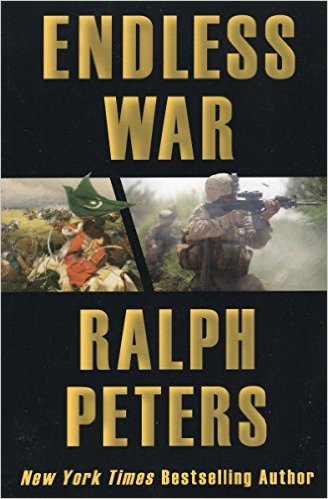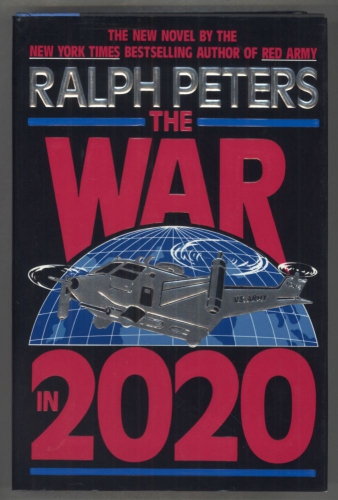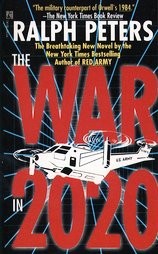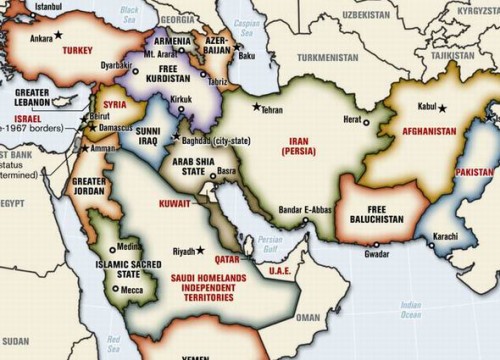lundi, 18 avril 2016
Ralph Peters: the concept of constant conflict

Ralph Peters: the concept of constant conflict
Retired Lieutenant Colonel of United States Army Ralph Peters, over the course of his military career, was in the Office of the Deputy Chief of Staff Intelligence and was responsible for the development of methods of future wars. Before becoming head of the department of Eurasia, he worked exclusively on finding solutions to problems of tactics. Graduating from the College of Command and General Staff of the US Armed Forces, the military expert has a master’s degree in international relations. During his service, Peters visited both professionally and personally more than 50 countries, including Russia, Ukraine, Georgia, Ossetia, Abkhazia, Armenia, Azerbaijan, Uzbekistan, Kazakhstan, Latvia, Lithuania, Estonia, Croatia, Serbia, Bulgaria, Poland, Hungary, the Czech Republic, Pakistan, Burma, Laos, Thailand, Mexico, and the Andean highlands. During the Cold War, he worked as an officer of US military intelligence for 10 years in Germany, after specializing in the Soviet Union. In retirement, he was released in 1998. Peters is known not only as an expert in the field of national and global security, intelligence, military strategy, and tactics, but also as a writer of fiction on military subjects, and as a rule he writes dystopia novels, reflecting, albeit in a different form, as well as in research papers on his visions for the near future.
 The most interesting thing about the point of view of the military expert is that it directly intersects with Alexandr Dugin’s comprehension of contemporary American hegemony as “Chaord” (Chaos+order) hegemony. Moreover, recent developments in the Arab world are directly related to these concepts, and Peters is exactly in line with his ideas about US policy in the region and the world at large. The article "Constant conflict", which most clearly reflecting Peters’ approach to analysis of modern geopolitics, came in 1997 in the "Options" military magazine.
The most interesting thing about the point of view of the military expert is that it directly intersects with Alexandr Dugin’s comprehension of contemporary American hegemony as “Chaord” (Chaos+order) hegemony. Moreover, recent developments in the Arab world are directly related to these concepts, and Peters is exactly in line with his ideas about US policy in the region and the world at large. The article "Constant conflict", which most clearly reflecting Peters’ approach to analysis of modern geopolitics, came in 1997 in the "Options" military magazine.
Peters describes the situation after the end of the Cold War as growing instability. The world is becoming involved in more and more conflict; no end of history is expected. Moreover, along with the processes of globalization and the process of development, a global tribalization emerges. In the article "Return of the tribes", published in the Weekly Standard magazine, he shows that while globalization creates a new global aristocracy, billions of people who have no place in this system cannot find themselves but through a new trend, which is the antithesis of globalization - tribalization which is manifested in ethnic and religious aspects. There is also the multi-million class of "soldiers": terrorists, guerrillas, members of voluntary, and clandestine groups, mercenaries operating outside the organized armies of national systems that challenge as nation-states US domination of the world. The world is becoming more dangerous and unstable.
The result of the globalization process will be the polarization of the world, strengthening its division into a winning minority and a losing majority. The last category includes not only all the countries of the "poor South", but a significant part of the population of the "rich North", where the differences in income and welfare between the rich and poor will only increase. In the article "Culture of a future conflict," Peters explains that future wars and conflicts will be determined by the inability of national governments to become effective system of distribution and control of resources. Whole cultures will play a role as competition. As a result, the class war is of such a magnitude that Marx could not imagine, and it will be combined with intercultural conflicts. They will be an integral feature of this century, defining the style and direction of conflict in the 21st century, just as the confrontation of ideologies did in the 20th.
Further computerization of society has not only positive but also negative effects. For the first time, an idea can spread faster than the most dangerous and deadly epidemics; by contaminating the mind they give rise to a new type of epidemic.
In the context of an ever-increasing flow of information, the accessibility and speed of communication processes of some societies, such as Russia, Serbia, Black Africa, and the Middle East, did not demonstrate sufficient flexibility in its assimilation and the ability to share a variety of quality information, and they will inevitably lose. And since, as Peters noted in the "Constant conflict", a country’s place in the global hierarchy of today is determined by how culture works with information, or more precisely as it adapts to the Post-Modern situation and information society, "the main task is to manage the information”. Societies that are in fear and therefore cannot control the free flow of information will not be competitive. They may own western technology for watching videos, but the West write the scripts, produce them, and collect royalties.
That is, the current globalization processes, contrary to liberal mythology, promotes dominance of some cultures and chaos and degradation of other cultures. Peters frankly calls democracy "a cleverly-liberal form of imperialism."
The resistance to the United States will become increasingly fierce.
"Those humans, in every country and region, who cannot understand the new world, or who cannot profit from its uncertainties, or who cannot reconcile themselves to its dynamics, will become the violent enemies of their inadequate governments, of their more fortunate neighbors, and ultimately of the United States. We are entering a new American century, in which we will become still wealthier, culturally more lethal, and increasingly powerful. We will excite hatred without precedent."
 According to the American strategist, one of the defining conflicts of the future will be a conflict between information masters and its victims. US’ main weapon here is American mass culture, brands, followed by, should it be necessary, military intervention.
According to the American strategist, one of the defining conflicts of the future will be a conflict between information masters and its victims. US’ main weapon here is American mass culture, brands, followed by, should it be necessary, military intervention.
“Contemporary American culture is the most powerful in history, and the most destructive of competitor cultures. While some other cultures, such as those of East Asia, appear strong enough to survive the onslaught by adaptive behaviors, most are not. The genius, the secret weapon, of American culture is the essence that the elites despise: ours is the first genuine people's culture. It stresses comfort and convenience--ease--and it generates pleasure for the masses. We are Karl Marx's dream, and his nightmare.”
Shows, series, movies, most despised by intellectual elite - showing extreme brutality and the most frank sex - is America’s most popular cultural weapon, and whether it is bought or pirated, it is replicated everywhere. Thus, cultural horizons of humanity are established and American hegemony and its ideology thrive.
In Peter’s world of constant conflict and informational domination of the US, the main thing is not to maintain order, but the violent suppression of the competitor; a place of long-term and global strategy takes local and tactical calculation. From the point of view of Peters, we will not have to deal with conventional wars, such as realpolitik, but the conflicts posed by collective emotions, local interests, and systemic collapses.
“There will be no peace. At any given moment for the rest of our lifetimes, there will be multiple conflicts in mutating forms around the globe. Violent conflict will dominate the headlines, but cultural and economic struggles will be steadier and ultimately more decisive. The de facto role of the US Armed Forces will be to keep the world safe for our economy and open to our cultural assault. To those ends, we will do a fair amount of killing.”
In his 2008 work “Never Quit the Fight”, Ralph Peters notes that new wars will lead the United States into a war of attrition, where “wars of attrition” are a continuous war until the total destruction of the enemy. In order to win the general postmodern war, he believes it is necessary to abandon the maxim "if you break something, it belongs to you," abandon the responsibility for what happens in areas where war is being waged.
However, in the general chaos, Peters insists that America should not only be limited to local actions to maintain its superiority. America has a mission, and this mission of democratization should not be sidelined, even if a certain authoritarian regime demonstrates dedication and loyalty to the United States. The US must carry democracy, but connecting all the global information networks is not a particularly democratic way of thinking about the implications for other countries.
Another idea is redrawing the boundaries of the world's borders. Peters is the author of the famous phrase "Greater Middle East", which is published in his article "Blood borders: How a better Middle East would look" in the ‘US Armed Forces Journal’, with comments from Ralph Peters.

Of all the world leaders who are a main enemy of the United States, according to Ralph Peters, a long time has been spent specializing on Russia and Putin. In the article "Why Putin should scare us", he calls him the most effective national leader belonging to the traditions of Russian aggressive nationalism. Putin restored the imperial power of Russia, and therefore should be eliminated.
Summing up the theoretical provisions of Peters about the future state of the world of conflict, his position on democratization, the need to eliminate imperially orientated leaders who are for the redrawing of boundaries, the violation of national sovereignty, the sovereignty of (a word he often uses as a quote) - it all sounds pretty ominous. In principle, one could perceive them as mere mental theoretical constructs, generated by an extravagant US military thinker and writer, but the analysis of what Obama and previous Bush administrations did shows a similar picture of the world. Peters’ expressive texts are key to the decisions of the current American leadership tediously written in diplomatic language. Ralph Peters rightly predicted the postmodernist-chaos oriented model of behavior. It’s very strange that today he criticizes Obama for the realization of his own ideas.
00:05 Publié dans Actualité, Géopolitique | Lien permanent | Commentaires (0) | Tags : chaos, nouvel ordre mondial, ralph peters, stratégie, géostratégie, géopolitique, politique internationale, chaordre, géopolitique du chaos, états-unis |  |
|  del.icio.us |
del.icio.us |  |
|  Digg |
Digg | ![]() Facebook
Facebook
vendredi, 04 mai 2012
Le retour du Colonel Peters
Ex: http://mbm.hautetfort.com/
 En juin 2006, le lieutenant-colonel retraité de l’US Army, Ralph Peters, s’était fait connaître par la publication dans l’Armed Force Journal d’une carte de sa main (voir ci-dessous) envisageant une complète refonte des frontières du « Grand Moyen-Orient » où G.W.Bush projetait d’injecter la démocratie parlementaire – et de marché ! – à l’occidentale.
En juin 2006, le lieutenant-colonel retraité de l’US Army, Ralph Peters, s’était fait connaître par la publication dans l’Armed Force Journal d’une carte de sa main (voir ci-dessous) envisageant une complète refonte des frontières du « Grand Moyen-Orient » où G.W.Bush projetait d’injecter la démocratie parlementaire – et de marché ! – à l’occidentale.
Certes, à l’époque tant l’énormité de ces modifications et le fait qu’apparemment, il ne s’agissait que de la publication d’une carte autorisaient à penser que les propositions du colonel Peters resteraient de simples élucubrations.
Pourtant, une série d’informations récentes pourrait toutefois indiquer que la fameuse carte n’a peut-être pas été reléguée au fond d’un tiroir poussiéreux.
Vers un Grand Azerbaïdjan ?
Mark Perry, auteur de Talking to Terrorists. Why America must engage with its enemies (Basic Books, 2010), révèle dans un article paru en mars et basé sur des fuites de Wikileaks[1] la coopération militaire aussi poussée que mal connue entre l’Azerbaïdjan et Israël et montre que l’usage de bases aériennes azerbaïdjanaises, dont celle de Sitalcay, pourrait permettre aux avions israéliens de bombarder, le cas échéant, plus efficacement l’Iran puisqu’il pourraient s’y poser après leurs raids plutôt que de devoir faire l’aller-retour vers leurs bases de départ. Toutefois, dans le même texte, Perry rappelle qu’en février 2012, un membre du parti au pouvoir à Bakou, capitale de la république dynastique et pétrolière d’Azerbaïdjan, en très bon termes avec l’Occident, a demandé à son gouvernement de rebaptiser le pays en Azerbaïdjan du Nord, appel qui relève d’un irrédentisme souhaitant « réunifier la patrie » en y rattachant les provinces azériphones du Nord-ouest de l’Iran[2], considérées comme l’Azerbaïdjan du Sud. Rappelons que plus de15 millions d’Azéris (selon les chiffres iraniens, apparemment minimisés) vivent dans le nord-est de l’Iran contre 9,1 millions en Azerbaïdjan même. D’où les craintes iraniennes d’un séparatisme azéri, qui s’était déjà manifesté, avec l’appui de l'URSS à la fin de la 2ème Guerre mondiale, par la création d’un Gouvernement populaire d'Azerbaïdjan séparatiste et hostile au Chah[3]. Une appréhension renouvelée à Téhéran suite à la naissance d’un Azerbaïdjan indépendant à la faveur du démantèlement de l’URSS.
Limitons-nous à observer que sur la carte du colonel Peters : le très récalcitrant Iran devrait se voir amputer au Nord-ouest de la région azérie de Tabriz, au Sud-ouest du Khouzistan arabophone et, au Sud-est, de sa province baloutche.
Un « Baloutchistan libre » ?
Tout récemment, le blog Atlas Alternatif titrait : « Des républicains américains veulent faire éclater le Pakistan » et faisait état d’une série d’auditions, le 8 février 2009, de la sous-commission des Affaires étrangères de la Chambre des États-Unis consacrées aux « violations des Droits de l’Homme au Baloutchistan », sous l’égide du député républicain de Californie Dana Rohrabacher. Rencontre qui avait soulevé la colère du gouvernement pakistanais. Étaient en effet conviés à ces auditions, outre des universitaires, des délégués d’Amnesty International et de Human Rights Watch, ce qui n’a rien d’étonnant vu le thème des rencontres, mais aussi le lieutenant-colonel Ralph Peters…
Autre « petite chose » à souligner : l’an dernier, l’ambassadeur US au Pakistan, Cameron MUNTER, a réitéré la demande de son gouvernement d’ouvrir un consulat au Baloutchistan[4].
Or, pour ce qui est du Pakistan, Peters envisageait l’amputation de sa province du Baloutchistan et la réunion de cette dernière avec les régions baloutches du sud-est de l’Iran pour former un État libre du Baloutchistan, doté ipso facto d’une importante façade sur l’océan indien avec, en son milieu, le port de Gwadar. C. à d. une remise en cause de la Ligne Goldschmid (1871) par laquelle Londres avait délimité la frontière entre l’Iran et son Empire des Indes, ligne frontalière reprise en 1947 par le Pakistan.
L’on sait déjà qu’au Baloutchistan – qui forme 42% du territoire du Pakistan, mais dont les 7 millions de Baloutches ne forment que 5% de sa population – opèrent des groupes tribaux armés, ulcérés non seulement de voir leur région négligée par Islamabad, mais faire l’objet d’une politique de peuplement pachtoune et pendjabi. S’ajoute à cela le fait que le sous-sol du Baloutchistan recèlerait d’immenses ressources en gaz et en pétrole.
Casser le « collier » chinois
Par ailleurs, la valeur stratégique du Baloutchistan s’est vue multipliée par la création, financée par la Chine lors de la décennie écoulée, d’un port en eaux profondes à Gwadar qui devrait constituer le terminal d’un gazoduc venant du Turkménistan. Ceci au risque d’aggraver le mécontentement de certains Baloutches, le nouveau port menaçant à leurs yeux d’accroître la fuite des ressources de la région et de créer principalement de nouveaux emplois parmi les « immigrés » du reste du Pakistan. Pour la Chine par contre, le projet de Gwadar comporte plusieurs avantages, ce qui justifie peut-être les accusations pakistanaises d’une aide de l’Inde à la guérilla baloutche. Gwadar désenclave en effet les provinces ouest de la Chine (Xinjiang), offre à sa marine des facilités portuaires situées à l’ouest de l’Inde et proches du « verrou stratégique » du détroit d’Ormuz, et permet à la RPC un approvisionnement, énergétique, à partir de l’Afrique et du Moyen-Orient, plus « terrestre », échappant donc en partie au contrôle américain des routes maritimes du Sud-est asiatique.Un « Baloutchistan libre » parrainé par Washington et Delhi et obtenant la haute main sur Gwadar n’aurait-il pas l’avantage d’ôter l’une des plus belles perles du « collier »[5] stratégique que Pékin tente de constituer à l’ouest de l’Inde et au nord de l’océan Indien ? Et cela alors même que le putsch du 7 février dernier aux Maldives, immédiatement cautionné par les Etats-Unis et la « plus grande démocratie du monde » que serait l’Inde, pourrait bien avoir mis fin aux souhaits chinois d’ajouter, avec une base de sous-marins dans l’atoll maldivien de Marao, une nouvelle pièce à leur parure.
La guerre de l’ombre que livrent des agents américains et israéliens dans plusieurs régions de l’Iran non-persanophones (Azerbaïdjan-occidental, Khouzistan, Sistan-Baloutchistan) n’est plus qu’un secret de polichinelle. Une guerre qui se déroule à l’occasion, avec une collaboration tacite… d’Al-Qaïda, à laquelle serait « affilié » le Jundullah, groupe sunnite du Baloutchistan iranien (le Sistan-Baloutchistan) partisan d’un système fédéral en Iran, qui, depuis 2005, s’est fait remarquer par une tentative d’assassinat de M. Ahmadinejad (septembre 2005), ses enlèvements de soldats iraniens, ses attentats contre des casernes de l’armée ou des Gardiens de la Révolution[6] ou contre des mosquées[7] ou des manifestations religieuses chiites[8], malgré le coup dur qu’a constitué pour l’organisation la capture et l’exécution, en juin 2010, de son leader Abdolmalek Righi.
Un peu plus à l’Ouest : un « réduit » alaouite ?
Par ailleurs, Fabrice Balanche, Maître de conférences à l’Université Lumière-Lyon II [9], écrivait dans la dernière parution d’Alternatives internationales (n°54, mars 2012) qu’en cas de débâcle du régime syrien, « le clan Assad peut tenter de créer grâce à ses moyens militaires un réduit dans la région alaouite, sur la côte, avec l’aide de Moscou et de Téhéran ». Or, ce « réduit alaouite » figure bel et bien sur la carte du colonel Peters, mais… inclus dans un « Greater Lebanon », un « Plus grand Liban », qui ferait main basse sur toute la côte syrienne jusqu’aux frontières turques, privant cette fois la Syrie, de surcroît dûment amputée de ses régions nord-est au profit d’un « Kurdistan libre », de toute façade maritime.
 De même, à la mi-mars, New Lebanon[10]estimait que « la vieille idée du mandat français » revenait à l’ordre du jour, « l’enclave alaouite [pouvant] devenir un État indépendant si Assad perdait tout contrôle sur Damas », et précisant que le clan Assad chercherait dans ce cas à élargir le « réduit alaouite » à la région de l’Idlib pour qu’il s’étende jusqu’à la frontière turque au-delà de laquelle vivent quelque 15 millions d’alévis.
De même, à la mi-mars, New Lebanon[10]estimait que « la vieille idée du mandat français » revenait à l’ordre du jour, « l’enclave alaouite [pouvant] devenir un État indépendant si Assad perdait tout contrôle sur Damas », et précisant que le clan Assad chercherait dans ce cas à élargir le « réduit alaouite » à la région de l’Idlib pour qu’il s’étende jusqu’à la frontière turque au-delà de laquelle vivent quelque 15 millions d’alévis.
Question : « le rejet régional et international » et « le refus total » de la Turquie d’un tel projet sont-ils aussi assurés que semble le penser New Lebanon ?
Sarkozy, apprenti Pandore
En Libye, la proclamation, le 6 mars dernier, de l’autonomie partielle de la Cyrénaïque, l’est du pays, par le cheikh Ahmed Zoubaïr Al-Senoussi, au demeurant neveu de l’ex-roi Idriss Al-Senoussi et s’exprimant au nom de quelque 3000 chefs de tribus et personnalités, est certes dues à des facteurs locaux – projet de loi électorale sur base démographique, sentiment d’abandon du « cœur de la révolution » en faveur de Tripoli – mais les accusations de projets séparatistes liés à la concentration des richesses pétrolières dans cette même région et bénéficiant d’un soutien occulte de « puissances étrangères » ne sont pas à rejeter sans plus.
Toujours en Libye, mais au Sud, les combats entre Toubous et tribus arabes dans la région de Sebha qui auraient fait quelque 150 morts entre le 26 et le 31 mars, pourraient ranimer les aspirations au séparatisme de ces mêmes Toubous.
À suivre donc…

Carte élaborée par le Lieutenant-Colonel américain Ralph PETERS et publiée dans le Armed Forces Journal en juin 2006. Peters est colonel retraité de l'Académie Nationale de Guerre US. (Carte sous Copyright 2006 du Lieutenant-Colonel Ralph Peters) – Source : Mahdi Darius NAZEMROAYA, Le projet d'un « Nouveau Moyen-Orient ». Plans de refonte du Moyen-Orient, in Mondialisation.ca, 11 décembre 2006
1er avril 2012
Paul DELMOTTE
Professeur de Politique internationale à l’IHECS
Source : Investig'Action michelcollon.info
[1] L’Azerbaïdjan, le terrain d’atterrissage secret d’Israël (http://www.slate.fr/story/52415/israel-iran-azerbaidjan-g...)
2] Provinces d’Azerbaïdjan occidental et oriental, d’Ardabil, de Zanjan et, partiellement, celles d’Hamadan et de Qazvin
3] Velléités séparatistes que l’on a cru voir se réveiller avec les manifestations survenues en 2006, e. a. à Nagadesh.
[4] Selon I.SALAMI, in Palestine Chronicle, 28.10.11
[5]L’on appelle poétiquement « stratégie du collier de perles » les efforts de la Chine en vue de s’assurer une série de bases navales pour mieux assurer ses approvisionnements énergétiques moyen-orientaux. À part Gwadar, les autres perles sont Chittagong (Bangla-Desh), Sittwe, Coco, Hiangyi, Khaukpyu, Mergui, Zadetkui Kyun (Myanmar), des bases en Thaïlande et au Cambodge, Hanbatota (Sri-Lanka). Depuis l’an dernier, un accord avec les Seychelles envisage la construction d’installations de réapprovisionnement de la marine chinoise.
[6] Comme en octobre 2009 (42 morts)
[7] Comme à Zahedan, en mai 2009 (25 morts) ou en juillet 2010 (26 morts)
[8] Comme à Chabahar en décembre 2010
[9] Auteur de La région alaouite et le pouvoir syrien (Karthala, 2006) et de l’Atlas du Proche-Orient arabe (PUPS-RFI, 2012), F.Balanche a également collaboré au volumineux et incontournable ouvrage dirigé e. a. par notre compatriote Baudouin Dupret, La Syrie au présent. Reflets d’une société, Sindbad/Actes Sud, 2007
00:05 Publié dans Actualité, Géopolitique | Lien permanent | Commentaires (0) | Tags : politique internationale, géopolitique, etats-unis, ralph peters, moyen orient, proche orient, caucase, azrbaïdjan, iran, syrie, beloutchistan, pakistan, cartes |  |
|  del.icio.us |
del.icio.us |  |
|  Digg |
Digg | ![]() Facebook
Facebook


